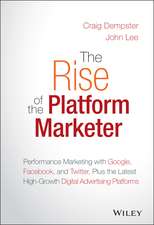The Affluent Consumer: Marketing and Selling the Luxury Lifestyle
Autor Ronald D. Michman, Edward M. Mazzeen Limba Engleză Hardback – 29 sep 2006 – vârsta până la 17 ani
Preț: 287.01 lei
Preț vechi: 349.37 lei
-18% Nou
Puncte Express: 431
Preț estimativ în valută:
54.93€ • 59.64$ • 46.14£
54.93€ • 59.64$ • 46.14£
Carte tipărită la comandă
Livrare economică 22 aprilie-06 mai
Preluare comenzi: 021 569.72.76
Specificații
ISBN-13: 9780275992828
ISBN-10: 0275992829
Pagini: 208
Dimensiuni: 156 x 235 x 21 mm
Greutate: 0.47 kg
Editura: Bloomsbury Publishing
Colecția Praeger
Locul publicării:New York, United States
ISBN-10: 0275992829
Pagini: 208
Dimensiuni: 156 x 235 x 21 mm
Greutate: 0.47 kg
Editura: Bloomsbury Publishing
Colecția Praeger
Locul publicării:New York, United States
Notă biografică
Ronald D. Michman is Professor Emeritus of Marketing at Shippensburg University in Pennsylvania. Previously, he held faculty positions at the Utica Campus of Syracuse University and at the University of New Hampshire. His articles have appeared in such publications as Business Horizons, Industrial Marketing Management, the Journal of Retailing, and the Journal of Business Strategy, and he served as Associate Editor of the abstract section of the Journal of Marketing and prepared bibliographies for the American Marketing Association. He is the author or co-author of ten books, including Lifestyle Marketing (Praeger, 2003), Specialty Retailers (Quorum, 2001), and The Food Wars (Quorum, 1998), with Edward Mazze.Edward M. Mazze is Distinguished University Professor of Business Administration at the University of Rhode Island, where he previously served as Dean of the College of Business Administration and holder of the Alfred J. Verrecchia-Hasbro Inc. Leadership Chair in Business. He consults extensively with industry executives and government officials on marketing, management, and economic development issues, and is a member of the Board of Directors of several public corporations. He is the author, co-author, and editor of over 150 articles appearing in such publications as the Journal of Marketing, the Journal of Retailing, the Journal of Advertising Research, and the Journal of Marketing Research, and eleven books, including Lifestyle Marketing (Praeger, 2003), Specialty Retailers (Quorum, 2001), and The Food Wars (Quorum, 1998), with Ronald Michman.
Cuprins
Preface Acknowledgments Chapter 1. Wealth in America Chapter 2. Bridging the Gap Chapter 3. When Good Is Not Good Enough Chapter 4. Changing Economic Dimensions Chapter 5. The Affluent All-American Consumer Chapter 6. Affluent Groups and Aspirations Chapter 7. Segmenting the Affluent Market Chapter 8. Upscale Strategies Are Not a Panacea Chapter 9. Redefining Affluent Consumer Lifestyles Chapter 10. Myths, Realities and Predictions Notes Selected Bibliography Index
Recenzii
Michman and Mazze describe the affluent consumer according to income and value of assets, and trace the growth of this segment, comparing past profiles to present trends. The increase in dual-income households in the past decade has contributed to this expansion. At one extreme are those confident about the future and concerned with their image, owning large homes and fancy cars; at the other, those who do not see themselves as affluent, maintaining modest homes and cars. The authors provide a wealth of statistical information to underscore the changes in the affluent sector over the years. They also address the impact of stereotypes in targeting the affluent, and the influence of various cultural factors and relevant myths. The affluent market today has blossomed into a global phenomenon. Marketers sorely need an improved understanding of this profitable segment to promote their products and services more effectively, which this book provides. Targeting requires customer cooperation coupled with the use of myriad research sources, via the Internet, telephone, and the traditional library. Eminently readable and highly interesting, this book is directed primarily at practitioners present and future, hence useful to upper-level undergraduate and graduate students as well. Recommended. Academic and professional library collections.
While a single profile no longer fits all affluent consumers, the market for luxury goods is a global one in which shoppers seek relevance, value, and fun. Drawing on their own research, Michman and Mazze examine this booming market, who constitutes it, and how businesses can meet lifestyle-based desires. They examine the strategies of companies from Tiffany to Wal-Mart for attracting wealthier seniors and others in the segmented market who cross-shop at both.
[T]he 194-page book is the first of its kind, according to Mazze, because it includes economic and demographic data, and the authors' expertise developed over decades from studying, teaching and consulting in marketing and consumer behavior. Mazze and Michman's book examines the affluent sector's growth and its increasing diversity, in terms of ethnicity, education, location and professional background..Unlike others, this book examines market segments, such as professional women managers, the African-American, Hispanic, Asian, and the gay and lesbian markets, as well as the aging population.
While a single profile no longer fits all affluent consumers, the market for luxury goods is a global one in which shoppers seek relevance, value, and fun. Drawing on their own research, Michman and Mazze examine this booming market, who constitutes it, and how businesses can meet lifestyle-based desires. They examine the strategies of companies from Tiffany to Wal-Mart for attracting wealthier seniors and others in the segmented market who cross-shop at both.
[T]he 194-page book is the first of its kind, according to Mazze, because it includes economic and demographic data, and the authors' expertise developed over decades from studying, teaching and consulting in marketing and consumer behavior. Mazze and Michman's book examines the affluent sector's growth and its increasing diversity, in terms of ethnicity, education, location and professional background..Unlike others, this book examines market segments, such as professional women managers, the African-American, Hispanic, Asian, and the gay and lesbian markets, as well as the aging population.



















